Introduction
Grasshoppers are a major pest of field crops, especially pulses, canola and wheat. By feeding directly on leaves, flowers and developing pods (for example lentils), grasshoppers can cause significant yield losses in these crops. The pest can also reduce forage, pasture and other natural food sources available for livestock or wildlife. However, only a few grasshopper species typically present in the field are pests which cause economic damage to crops.
Management of grasshoppers is a challenge due to the sporadic nature of outbreaks, as the pest may not be present in significant numbers and in a given location every year. Weather conditions in previous and current years are a key factor influencing distribution and infestation levels. High numbers of grasshoppers can result in rapid removal of vegetation allowing a short window of opportunity for control. Growers rely mainly on insecticide applications to protect their crops, but viable alternative solutions and tools were needed to effectively address the challenges with grasshopper management.
The Pesticide Risk Reduction team of Agriculture and Agri-Food Canada's Pest Management Centre collaborated with key stakeholders to develop a strategy for sustainable grasshopper management in field crops. It funded several projects to address the gaps identified in this strategy, such as the need for knowledge on species identification, decision support systems and biological control options. This factsheet summarizes some of the tools developed as a result of this work.
Advanced grasshopper management: a two-pronged approach
I. Distinguishing pest from non-pest grasshoppers: the field guide
Not all grasshoppers are pests. Among the more than 80 species of grasshoppers in Canada, only about four are known to cause serious economic losses to agricultural crops. The majority of species are not only harmless to crops, but actually provide a food source for many birds and other wildlife in grassland ecosystems. Some grasshopper species may not even be a problem at all stages of plant growth, and only causing economic damage at certain crop development stages.
An illustrated booklet (Figure 1) containing over 60 colored images of various grasshopper species at different life-stages (Figure 2), along with guidance on monitoring and control approaches was developed and published. The booklet emphasizes identification features such as life-cycle, behavioural, and appearance features which set apart pest from non-pest species of grasshoppers.
Knowing which species of grasshoppers in your field need to be controlled makes pest control decisions clearer and reduces pest management costs and undesirable impacts by avoiding unnecessary sprays.
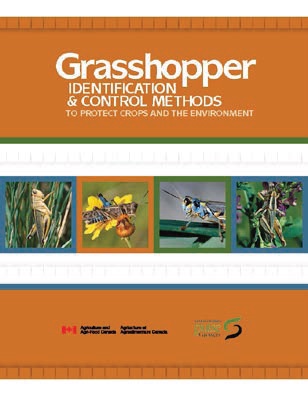
Description: Figure 1
Second edition of the grasshopper booklet authored by Dr. Dan Johnson and published in spring 2008 in collaboration with Pulse Canada and Saskatchewan Agriculture and Food. This is an expanded and upgraded version of the 1st edition published in 2006.
The Grasshopper Identification & Control Methods booklet is available electronically from the Government of Canada Publications website.
How to tell if a grasshopper is a pest or not
"Any grasshopper flying before June, singing, having bright coloured wings, and not causing chewing damage is not a pest" writes University of Lethbridge professor and author of the booklet, Dr. Dan Johnson. "Pest grasshopper species hatch in late May and early June, are brown or black in colour and do not have large wings. Monitoring of the crops should be conducted regularly. If scouting fields and seeing grasshoppers, you should be able to identify them using this booklet to make sure you have got the right pest species to be sprayed".
Figure 2: Example images in the booklet of key pest species in the prairies:
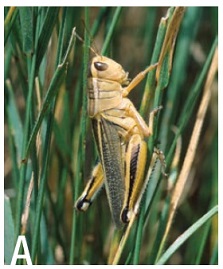
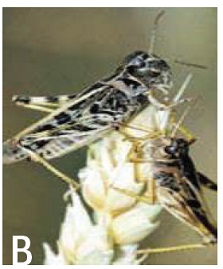
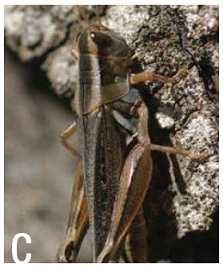

"The booklet was popular with growers – says Mr. Carl Potts, Executive Director of Saskatchewan Pulse Growers - many of whom commented that this was the only tool that allowed them to distinguish between grasshopper species that required pest control and those that did not".
Thousands of print copies of the booklet have been made available to prairie growers and crop advisors through Saskatchewan Pulse Growers (SPG) association, Saskatchewan Agriculture and Food, Association of Alberta Agricultural Fieldmen, Pulse Canada, and Canola Council of Canada. These and numerous knowledge transfer activities through workshops, web seminars and industry meetings led to an increased grower uptake of the guide and overall awareness of integrated grasshopper management.
II. Early warning of grasshopper risk
Weather and abundance of viable insect eggs early in the season are the most significant factors in forecasting the activity and risk from grasshopper outbreaks. A weather-based forecasting model that predicts in-season grasshopper hatching and development was developed by Dr. Johnson and his research team. The model was translated into an on-line tool designed to provide growers with risk maps indicating expected growth stages of the main pest grasshopper species across the Prairies (Figure 3).
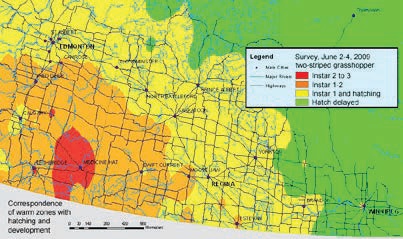
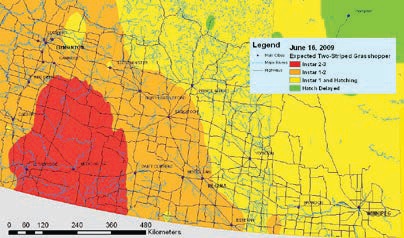
Figure 3: Examples of risk maps showing regional periodic warning scenarios (for example June 2 and June 16, 2009) of two-striped grasshopper instar development following hatching.
A test version of the forecasting tool was made available to growers on a pilot basis through the SPG website in summer 2009. Maps were posted on-line at the beginning of May and updated twice weekly throughout the season providing an interpretation of the risk and recommended actions. The maps proved to be a useful tool in providing reliable estimates of grasshopper development in the field. In a cool weather situation, such as that encountered during summer 2009, these predicted slow progress in insect activity and development, and these predictions were supported by observations in the field. In a warmer season, the insect is anticipated to appear much sooner and progress much faster through growth stages. An accurate forecast of spring hatching can provide much needed early warning helping growers make informed management decisions throughout the season.
Best management practices: integrating a variety of tools
In any given year, growers need to be able to anticipate the hatching and development of pest grasshopper species, properly manage time invested in field monitoring when it will be most productive, ignore the appearance of non-pest species, and make informed decisions about appropriate spray actions to target pest species where and when these reach economic damage numbers.
Sustainable management of grasshopper outbreaks can be achieved when combining accurate pest identification with pest risk prediction tools and low risk control products, such as biopesticides, in an integrated systems approach.
Using a diversified control tool-box for grasshopper management can significantly contribute to reducing the risks associated with pesticide use in large acreage crops. Integrating a biopesticide into the rotation can also help to minimize the risk of pests developing resistance to chemical pest control products.
The solutions described above are complementary and can be integrated as part of a system's approach offering useful synergies for grasshopper management. Ultimately, these can help growers address the technology gaps from eventual loss of pesticide uses while reducing crop protection costs and optimizing pesticide resistance management.
About Pesticide Risk Reduction at the Pest Management Centre
The Pesticide Risk Reduction team of Agriculture and Agri-food Canada's Pest Management Centre (PMC) focuses on developing and implementing reduced risk solutions for pest management issues that have been identified by growers. To view the teams current priorities and the issues being addressed. To consult other factsheets in this series.